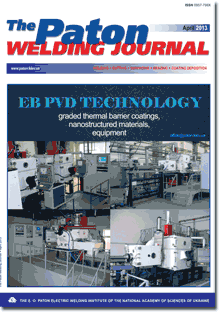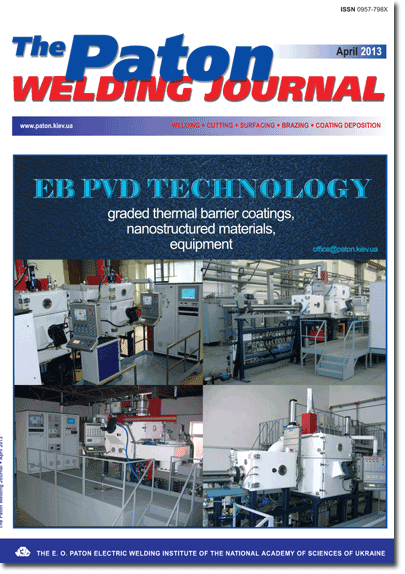| 2013 №04 (02) | 2013 №04 (04) |

The Paton Welding Journal, 2013, #4, 15-20 pages
CRACKS IN WELDED JOINTS OF LARGE DIAMETER PIPES AND MEASURES FOR THEIR PREVENTION
A.A. RYBAKOV, T.N. FILIPCHUK and L.V. GONCHARENKO
E.O. Paton Electric Welding Institute, NASU, Kiev, Ukraine
Abstract
Considered are the cases of failure of main gas pipelines, including after long-term operation, caused by presence of crack-like defects in the welded joints of pipes which were formed at their manufacture. Analysis of main reasons of appearance of such defects in weld metal and heat-affected zone is provided considering the peculiarities of technological processes of manufacture and welding of pipes. It is shown that cracks can have different orientation and origin, being formed immediately in the process of welding or at later stages of manufacture during performance of adjacent operations, for example, pipe expanding. Their formation is caused by series of technological reasons, for example, movement of welded edges of pipe in process of assembly, incorrect selection of consumables (welding wire, flux), local change of weld metal chemical composition or its structural inhomogeniety due to entering of exogenous particles in weld, increased flux humidity etc. Measures for prevention of appearance of crack-like defects in welded joints of pipes are described. Research results can be used in tube-welding production for improvement of welding technology and control of tubular products, as well as inspection of pipelines in process of their operation. 9 Ref., 1 Table, 9 Figures.
Keywords: arc welding, main oil-gas pipelines, welded joints, failure, cracks, reasons of formation, prevention
Received: 12.02.13
Published: 28.04.13
References
1. Kuznetsov, V.V., Lyapin, A.A., Monakhov, R.E. (2007) Comparative analysis of statistical data on accident rates in main pipelines of Russia and Western Europe. Neft, Gaz and Bizness, 1/2, 49-56.
2. Mazur, I.I., Ivantsov, O.M. (2004) Safety of pipeline systems. Moscow: Elima.
3. Mandelberg, S.L., Rybakov, A.A., Sidorenko, B.G. (1972) Resistance of pipe steel welded joints to solidification cracks. Avtomatich. Svarka, 3, 1-4.
4. Mandelberg, S.L., Rybakov, A.A., Fajnberg, L.I. et al. (1972) CO2 welding of assembly longitudinal welds of large diameter pipes. Ibid., 11, 56-58.
5. Mandelberg, S.L., Semyonov, S.E. (1962) Formation of shrinkage cavities on weld surface in submerged multiarc welding with higher speed. Ibid., 6, 17-20.
6. Mandelberg, S.L., Buslinsky, S.V., Bogachek, Yu.L. (1984) Influence of hydrogen on cold crack formation in welding of pipe steels. Ibid., 2, 2-5.
7. Makarov, E.P. (1981) Cold cracks in welding of alloy steels. Moscow: Mashinostroenie.
8. Hrivnak, I. (1984) Weldability of steels. Moscow: Mashinostroenie.
9. Mandelberg, S.L. (1965) Higher speed multiarc welding with electrode weaving. Avtomatich. Svarka, 2, 8-13.
Suggested Citation
A.A. RYBAKOV, T.N. FILIPCHUK and L.V. GONCHARENKO (2013) CRACKS IN WELDED JOINTS OF LARGE DIAMETER PIPES AND MEASURES FOR THEIR PREVENTION. The Paton Welding J., 04, 15-20.The cost of subscription/purchase order journals or individual articles
| Journal/Currency | Annual Set | 1 issue printed |
1 issue |
one article |
| TPWJ/USD | 384 $ | 32 $ | 26 $ | 13 $ |
| TPWJ/EUR | 348 € | 29 € | 24 € | 12 € |
| TPWJ/UAH | 7200 UAH | 600 UAH | 600 UAH | 280 UAH |
| AS/UAH | 1800 UAH | 300 UAH | 300 UAH | 150 UAH |
| AS/USD | 192 $ | 32 $ | 26 $ | 13 $ |
| AS/EUR | 180 € | 30 € | 25 € | 12 € |
| SEM/UAH | 1200 UAH | 300 UAH | 300 UAH | 150 UAH |
| SEM/USD | 128 $ | 32 $ | 26 $ | 13 $ |
| SEM/EUR | 120 € | 30 € | 25 € | 12 € |
| TDNK/UAH | 1200 UAH | 300 UAH | 300 UAH | 150 UAH |
| TDNK/USD | 128 $ | 32 $ | 26 $ | 13 $ |
| TDNK/EUR | 120 € | 30 € | 25 € | 15 € |
AS = «Automatic Welding» - 6 issues per year;
TPWJ = «PATON WELDING JOURNAL» - 12 issues per year;
SEM = «Electrometallurgy Today» - 4 issues per year;
TDNK = «Technical Diagnostics and Non-Destructive Testing» - 4 issues per year.


